#Convention on Biological Diversity (CBD)
Text
Pollution by waste has adverse impacts on human health and biological diversity.
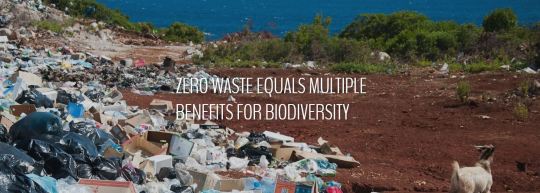
Plastic waste is a case in point: according to the World Bank, it accounted for 12 percent of all municipal solid waste in 2020. The harmful chemicals it contains make plastic waste hazardous for both people and nature. The sheer scale of plastic leakage into the environment is disrupting habitats and natural processes. A 2016 technical report by the Secretariat of the Convention on Biological Diversity (CBD) indicated that marine debris is a globally significant stressor on the marine and coastal environment. 800 marine species are affected by plastic pollution, including microplastics that are ubiquitous in the ocean.
Learn about the adverse impacts of Pollution by waste.
#Pollution by waste#waste management#international day of zero waste#30 march#chemical waste#waste pollution#convention on biological diversity (CBD)#campaign
0 notes
Text
Convention on Biological Diversity (CBD) Acting Executive Secretary Message for World Wildlife Day 2024.
youtube
Executive Secretary, Mr David Cooper of the Convention on Biological Diversity on World Wildlife Day 2024.

0 notes
Text
Statement by the Convention on Biological Diversity (CBD) on International Day of the World's Indigenous Peoples 2023.
Statement by Acting Executive Secretary of the Convention on Biological Diversity, David Cooper EN | video statement
#Convention on Biological Diversity (CBD)#International Day of the World's Indigenous Peoples#statements#9 august#right to self determination#indigenous youth
0 notes
Text
Inspire global actions towards the International Day for Biological Diversity 2023 on May 22nd.

Get the International Day of Biodiversity 2023 communication and campaign materials!
22 May, The International Day for Biological Diversity has gained global prominence through the efforts of the United Nations, governments, indigenous peoples and local communities, non-governmental organizations and concerned individuals. Each has highlighted their innovative solutions to the biodiversity crisis to the forefront of global conversations on sustainable development.
Although every Biodiversity Day carries its own special significance, this year’s global celebrations bring with it a renewed sense of hope with the adoption of the Kunming-Montreal Global Biodiversity Framework at COP 15.
United Nations Biodiversity
#HarmonyWithNature#30by30#ForNature#ActionDecade#post2020#international day for biological diversity#Biodiversityday#Convention on Biological Diversity (CBD)#United Nations Biodiversity#campaign#22 may#Buildbackbiodiversity
0 notes
Text
2022 United Nations Biodiversity Conference (COP15) - Why COP15 is Important
The 2022 United Nations Biodiversity Conference will be held from 7-19 December 2022, in Canada. The Convention on Biological Diversity (CBD) was planned first in April 2022 in China, but it was postponed, for 4 times. The Conference was originally scheduled for October 2020, but was delayed due to Covid-19. In June 2022, U.N. Secretariat said that it will be held in December 2022 in Montreal, Canada, also China’s environment ministry said in a separate statement.
9 notes
·
View notes
Text
Statement by the Executive Secretary of the Convention on Biological Diversity, on the occasion of the World Health Day 2024; April 7th.
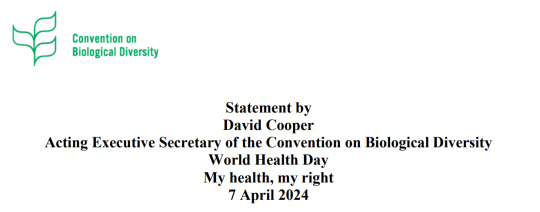
As declared by the United Nations General Assembly in July of 2022, all people have the right to a clean, healthy and sustainable environment. The fulfillment of this right is necessary for the full enjoyment of a wide range of human rights, including the rights to health, food, and water. And it requires that we protect nature. Our health depends on nature, or biodiversity, in so many ways. The variety of plants, animals and microorganisms provides us with essential medicines and nutritious food. Wetlands, forests, and other
ecosystems regulate the climate and protect the supply and quality of water. Urban green and blue spaces support our physical and mental health. But we are losing biodiversity faster than ever before. This loss threatens the multiple contributions of nature to our health. It increases the risk of disease, including pandemics, and our exposure air and water pollution and to extreme events. Children, women, and the elderly are especially vulnerable. Biodiversity loss also has severe adverse impacts on the health of indigenous peoples and their unique interdependent relationship with local ecosystems, impacting physical, mental, emotional, and spiritual health. The Kunming-Montreal Global Biodiversity Framework (the Biodiversity Plan) was agreed by all countries to halt and reverse the loss of biodiversity by 2030. Its four goals aim to protect and restore
nature, to prosper with nature, to share benefits fairly, and to invest and collaborate for nature. This Biodiversity Plan is underpinned by a human rights approach, and it recognizes that the health of humans, animals and plants, wild and domestic, and the integrity of ecosystems are all linked and interdependent. Achieving the goals and targets of the Plan is essential to realize our right to health. We must all be part of the Plan.
This World Health Day, as we promote “My health, my right”, lets us all be part of the Plan. Let us redouble our efforts to protect life on earth. Our health and that of future generations depends on it.
Mr.David Cooper, CBD Executive Secretary.
#righttosafeenvironment#right to life#right to health#my health my right#world health day#Convention on Biological Diversity (CDB)
0 notes
Text
4 Largest Wildlife Conservation Project in India
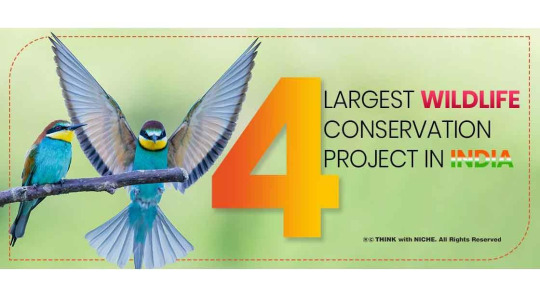
India has had an ignorant attitude toward the environment and environmental preservation. This ignorant attitude has led to much of the damage that India has procured over the years. Nature is hugely exploited in our land and there are no two ways about it. The government, for a long time, didn't do anything to heal the damage that was done. It was after much outrage from many environmental activists that the government began to undertake wildlife preservation or conservation projects.
Over the past decade, a lot has changed. The environment has become an election issue now and there is a lot more awareness of our environment and Global warming in India. Even a lot of common citizens are aware of their duty towards the environment. The biggest example is that of the Aarey forest in Maharashtra. The famous Aarey in Mumbai is one of the few green areas left in the city. In 2020, the government of Maharashtra decided to pass a metro line through Aarey and that led to a huge public outcry. After a huge protest and online outrage, the government had to shift the metro line to a different area. This was completely done by the common citizens. So there definitely has been a huge change in the attitude of the public. Let's now look at the 4 largest Wildlife Conservation projects in India.
India's wildlife is governed by legal provisions
The citizens of India have a fundamental duty to safeguard wildlife and show compassion for all living things under Article 51A(g) of the Constitution of India, 1950. In addition, Article 48A stipulates that it is the responsibility of the State to defend and seek to improve the nation's forests and wildlife. The Constitution's Concurrent List, or Schedule VII List III, includes the subject of protecting wild animals and birds. This shows that the subject can be governed by both the Union and the State Government.
Regulation of Wildlife through International Treaties
The improvement of wildlife conservation may benefit from the use of international wildlife legislation. For the conservation of wildlife, there are numerous national and international instruments. The Convention on International Trade in Endangered Species (CITES), the Convention on Migratory Species (CMS), the Convention on Biological Diversity (CBD), and others are a few of them.
To Read This Full ARTICLE, Click Here
0 notes
Text
Les #crises #climat et #biodiversité constituent une urgence globale de #santé publique : un appel de 200 journaux scientifiques via Philippe Grandcolas @pgISYEB
See on Scoop.it - Insect Archive
Les #crises #climat et #biodiversité constituent une urgence globale de #santé publique : un appel de 200 journaux scientifiques https://t.co/9BL9uJDN3M
— Philippe Grandcolas (@pgISYEB) November 22, 2023
Les #crises #climat et #biodiversité constituent une urgence globale de #santé publique : un appel de 200 journaux scientifiques https://t.co/9BL9uJDN3M
— Philippe Grandcolas (@pgISYEB) November 22, 2023
Time to treat the climate and nature crisis as one indivisible global health emergency - The Lancet, 25.10.2023 https://www.thelancet.com/journals/lancet/article/PIIS0140-6736(23)02289-4/fulltext
References
Scientific outcome of the IPBES-IPCC co-sponsored workshop on biodiversity and climate change.
IPBES Secretariat, Bonn2021
Many risky feedback loops amplify the need for climate action.
One Earth. 2023; 6: 86-91
Key messages from European Science Academies for UNFCCC COP26 and CBD COP15.
Ocean science: the power of plankton.
Nature. 2012; 483: S17-S20
The role of Indigenous peoples and local communities in effective and equitable conservation.
Ecol Soc. 2021; 26: 19
The role of soil carbon in natural climate solutions.
Nat Sustain. 2020; 3: 391-398
Homogenization of the terrestrial water cycle.
Nat Geosci. 2020; 13: 656-658
Call for emergency action to limit global temperature increases, restore biodiversity, and protect health.
Lancet. 2021; 398: 939-941
COP27 Climate Change Conference: urgent action needed for Africa and the world.
Lancet. 2022; 400: 1563-1565
Connecting global priorities: biodiversity and human health: a state of knowledge review.
How antimicrobial resistance is linked to climate change: an overview of two intertwined global challenges.
Int J Environ Res Public Health. 2023; 201681
“Without nature, we have nothing”: UN chief sounds alarm at key UN biodiversity event. UN News.
State of the world's drinking water: an urgent call to action to accelerate progress on ensuring safe drinking water for all.
Catchment to sea connection: impacts of terrestrial run-off on benthic ecosystems in American Samoa.
Mar Pollut Bull. 2021; 169112530
Assessment report on the sustainable use of wild species.
https://www.ipbes.net/sustainable-use-assessment
Date: August, 2022
Date accessed: October 1, 2023
Ocean acidification and human health.
Int J Environ Res Public Health. 2020; 174563
Climate change “already” raising risk of virus spread between mammals. Carbon Brief.
https://www.carbonbrief.org/climate-change-already-raising-risk-of-virus-spread-between-mammals/
Date: April 28, 2022
Date accessed: October 1, 2023
Interaction of the microbiota with the human body in health and diseases.Biosci Microbiota Food Health. 2020; 39: 23-32
Caring for country and the health of Aboriginal and Torres Strait Islander Australians.
Med J Aust. 2017; 207: 8-10
The Lancet Countdown on Health and Climate Change: policy brief for the UK.
https://s41874.pcdn.co/wp-content/uploads/Lancet-Countdown-2022-UK-Policy-Brief_EN.pdf
Date: 2022
Date accessed: October 1, 2023
Assessing quality of life using WHOQOL-BREF: a cross-sectional study on the association between quality of life and neighborhood environmental satisfaction, and the mediating effect of health-related behaviors.
BMC Public Health. 2018; 181113
Biodiversity impacts and conservation implications of urban land expansion projected to 2050.
Proc Natl Acad Sci USA. 2022; 119e2117297119
COP15: nations adopt four goals, 23 targets for 2030 in landmark UN Biodiversity Agreement. Convention on Biological Diversity.
https://www.cbd.int/article/cop15-cbd-press-release-final-19dec2022
Date: Dec 12, 2022
Date accessed: October 1, 2023
Exceeding 1·5°C global warming could trigger multiple climate tipping points.
Science. 2022; 377eabn7950
WHO guidance for the use of Annex 2 of the International Health Regulations (2005).
https://www.who.int/publications/m/item/who-guidance-for-the-use-of-annex-2-of-the-international-health-regulations-(2005)
Date accessed: October 1, 2023
Consultation on Australia's first National Health and Climate Strategy.
https://www.health.gov.au/news/consultation-on-australias-first-national-health-and-climate-strategy
Date: July 26, 2023
Date accessed: October 1, 2023
0 notes
Text
Final text of Kunming-Montreal Global Biodiversity Framework: Goals & Targets
The final text of the historic Kunming-Montreal Global Biodiversity Framework, agreed at the 15th meeting of the Conference of Parties to the UN Convention on Biological Diversity is now available as document CBD/COP/15/L25
Official CBD Press Release - 22 December 2022, Montreal https://prod.drupal.www.infra.cbd.int/sites/default/files/2022-12/221222-CBD-PressRelease-COP15-Final.pdf?_gl=11vkq29o_gaMzA3ODg2MzIwLjE2NzM0NDc1NDg._ga_7S1TPRE7F5*MTY5Mjg3NDIyNi4xLjEuMTY5Mjg3NTYyOC42MC4wLjA.
Text in all UN languages: https://www.cbd.int/conferences/2021-2022/cop-15/documents
0 notes
Text
Fellowships for Journalists to Cover the Seventh Global Environment Facility (GEF) Assembly in Vancouver, Canada
The Global Environment Facility (GEF) is a multilateral environmental fund that provides funding to assist low- and middle-income countries in meeting the objectives of international environmental conventions such as the Convention on Biological Diversity (CBD), United Nations Framework Convention on Climate Change (UNFCCC), Stockholm Convention on Persistent Organic Pollutants (POPs), UN…

View On WordPress
0 notes
Text
Yili's Premium Brand SATINE Responds to COP15's Call to Build a Shared Future for All Life on Earth with Its Ongoing Commitment to Preserving Biodiversity
https://questlation.com/prnewswire/347aa796726318c95211bcb19d56c470/?feed_id=43343&_unique_id=643d3f4165efa
0 notes
Text
La comunidad científica se une en pos de la conservación de la biodiversidad del planeta
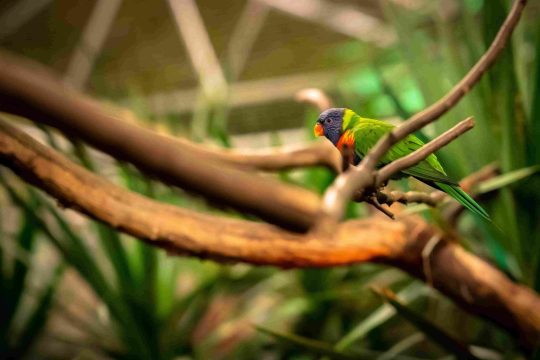
Los científicos más destacados del mundo que están abocados a la conservación ambiental , alertan de la urgente necesidad de tomar acciones para conservar al menos el 30 % del planeta para el año 2030.
En el mes de enero del año 2021 un grupo de investigadores alzaba la voz para alertar al mundo de la acuciante situación en relación a la pérdida masiva de biodiversidad ambiental en el mundo. «La humanidad está provocando una rápida pérdida de biodiversidad y, con ella, la capacidad de la Tierra para sustentar vida compleja. Se debe actuar ya mismo para frenar esta cadena hacia un espiral del cual no se puede retornar a nivel biológico» decía el informe.
En paralelo con otras investigaciones científicas, incluido el histórico informe de la Plataforma Intergubernamental Científico-normativa sobre Diversidad Biológica y Servicios de los Ecosistemas (Intergovernmental Science-Policy Platform on Biodiversity and Ecosystem Services, IPBES) de 2019, el documento refuerza la urgencia de que el Convenio sobre la Diversidad Biológica (Convention on Biological Diversity, CBD) impulse una estrategia urgente, ambiciosa y transformadora para disminuir la cuantiosa pérdida de biodiversidad a nivel planetario para el 2030.
Este documento elaborado por los más destacados científicos del mundo en materia de biodiversidad, pretende apoyar a las partes que participan en las negociaciones del CBD (Convenio sobre la Diversidad Biológica) mediante la recolección, el enlace y el resumen de algunos de los análisis científicos y económicos más pertinentes en relación con la pérdida de biodiversidad y el cambio climático.
La evidencia científica en primera plana
Específicamente, este documento provee un detalle de los puntos más relevantes de investigaciones de expertos sobre los siguientes temas:
Evidencia científica que valida un enfoque de la conservación basado en derechos básicos del hombre.
Datos en relación a las implicaciones económicas de la pérdida de biodiversidad.
Medición del financiamiento que reciben los proyectos orientados a la conservación de la biodiversidad y su impacto concreto.
Detalle de los beneficios económicos puntuales en relación con la conservación de la biodiversidad en las regiones clave del planeta.
Evidencia para vincular mejor las estrategias de clima y biodiversidad.
Evidencia acerca de cómo la conservación de la naturaleza puede prevenir pandemias .
Evidencia en cómo las áreas marinas protegidas brindan seguridad alimentaria y otros beneficios al hombre .
La mirada de la ciencia en relación a la conservación de la biodiversidad ambiental pudo advertir que hacia fines del año 2020, el planeta se encaminaba al cumplimiento del objetivo global establecido en 2010 de proteger el 17 % de la tierra y el 10 % del océano.
Si bien, aunque la meta es firme y el compromiso a nivel global va en aumento. Aún se necesitan avances concretos en áreas puntuales para alcanzar los elementos clave de ese objetivo. Por ejemplo, contar con profesionales idóneos que se aboquen a realizar una gestión equitativa y eficaz , y que además pongan en foco de atención prioritaria a las áreas más importantes para la biodiversidad.
Proteger la biodiversidad supone un fuerte compromiso de los gobiernos mundiales
Las investigaciones científicas han demostrado que los líderes mundiales deben acrecentar su compromiso en lo que respecta a la protección de las áreas protegidas y conservadas en la actualidad. Es necesario que puedan sumarse con más énfasis al objetivo global, científicamente creíble y necesario de proteger o conservar al menos el 30 % de la tierra y los océanos del mundo para el año 2030.
Los científicos concluyeron en su análisis que entre el 25 % y el 75 % de una región a proteger para el futuro, debe gestionarse de modo serio e inteligente para su conservación efectiva. Las áreas de rica biodiversidad a conservar no deben dejarse sin monitoreo y control por períodos muy espaciados de tiempo. Se debe realizar una evaluación permanente para monitorear en qué estado de salud ambiental se encuentra la zona con el fin de proteger la biodiversidad del área mes a mes, sin claudicar en el esfuerzo.
En este sentido una revisión exhaustiva de la bibliografía científica arrojó que , en promedio, el 37 % de un área marina debe ser protegida para lograr los objetivos ambientales y socioeconómicos de la misma. Una encuesta realizada a 335 científicos conservacionistas de 81 países puso de relieve «un apoyo muy fuerte» para conservar un gran porcentaje, «de alrededor del 50 %», del planeta. Esta acción lograría proteger al 85 % de las especies que habitan el planeta de la extinción.
En otro artículo científico histórico publicado en la prestigiosa revista Science Advances, expertos mundiales señalaron la necesidad imperiosa y urgente de proteger al menos el 30 % de la tierra y los océanos del planeta para el año 2030. Además de la detección temprana de otro 20 % de áreas del planeta que sería necesario conservar y que funcionarían, llegado el momento,como «áreas de estabilización del clima». Según los investigadores, estas áreas que serían protegidas de la expoliación del hombre actual, en el futuro, por permanecer en ‘estado natural’, estarían resguardadas de los cambios a gran escala de la cubierta vegetal. Cumplimentar estos objetivos , dijeron los expertos, conservaría la biodiversidad y ayudaría a lograr los objetivos del Acuerdo Climático de París.
Originally published at http://accionbiodiversidadblog.com/ on March 14, 2023.
0 notes
Text
What you can do to celebrate International Day for Biological Diversity 2023!
Learn about the 22 Actions for Biodiversity.

Clean up an area around you
Restore an area, near or far
Take pictures not samples
Help animals, big and small
Prevent the spread of zoonotic diseases
Plant (native) trees, shrubs and plants
Consume responsibly
Save energy
Share
Buy biodiversity-friendly products
Help someone stop smoking
Enjoy urban biodiversity
Support companies committed to ethical standards
Change one habit that is negative for biodiversity
Ask businesses to source responsibly
Minimize waste
Learn about biosafety
Support biodiversity-friendly companies
Support environmental organizations
Raise biodiversity awareness
Empower someone
Celebrate Biodiversity Day!
#Cleanup#saveenergy#biodiversity-friendly products#BiodiversityDay#Biosafety#Consumeresponsibly#22 may#Take action#United Nations Biodiversity#Convention on Biological Diversity (CBD)
0 notes
Text
Expert Panel on Forests and Human Health.

IUFRO's Global Forest Expert Panel (GFEP) on Forests and Human Health will host a webinar on March 21, where they will discuss the key messages of their latest assessment. There is growing evidence that nature, particularly forests, contributes to physical and mental well-being and can notably improve human health.
Webinar: Expert Panel on Forests and Human Health.
The United Nations estimates that less than half of the global population is covered by essential health services. Adding to the low rate of coverage, the ongoing COVID-19 pandemic has caused further healthcare disruptions that could reverse decades of improvements. Moreover, in recent years, there has been a surge in zoonotic diseases such as COVID-19, SARS, MERS, Ebola, Malaria, and the avian flu, and illness and deaths from such diseases are expected to spike in the future. The implementation of the 2030 Agenda for Sustainable Development and its 17 Sustainable Development Goals (SDGs) can strengthen the momentum for combatting these pressing challenges. The third Sustainable Development Goal (SDG 3) aims to ensure healthy lives and promote well-being for all at all ages.
Several studies have concluded that nature, particularly forests, contribute to physical and mental well-being and can notably improve human health. Forests can act as a buffer that maintains well-being, provides resources (e.g., food and medicine) and services such as air purification or recreation, especially in urban areas, potentially reducing exposure to environmental diseases and other hazards. However, the relationship between forests and human health is complex, as evidence also shows that forest proximate communities are more prone to zoonotic and infectious diseases, which are often exacerbated by forest degradation and encroachment.
Consequently, in July 2021, IUFRO initiated a global scientific assessment on forests and human health in the frame of the Collaborative Partnership on Forests (CPF)'s Global Forest Expert Panels (GFEP) initiative. The assessment will provide reliable and synthesized scientific information, crucial to efficiently utilize the synergies and achieve optimal trade-offs between human health, and the conservation, restoration, and sustainable management of forest ecosystems, their biodiversity (including wildlife), as well as trees in other land-uses. The report and the accompanying policy brief will also present response options relevant to the policy context at various levels.

This global assessment report planned to be published in March 2023, will contribute to the implementation of the 2030 Agenda for Sustainable Development by highlighting the nexus between SDG 3: Good Health and Well-Being and SDG 15: Life on Land, as well as relevant links to other SDGs. The assessment will provide input to the 2023 session of the UN High-Level Political Forum on Sustainable Development (HLPF 2023), the 18th session of the United Nations Forum on Forests (UNFF18) and other international forums considering forest-related issues, such as the Conference of the Parties to the Convention on Biological Diversity (CBD COP-16) and the UN Climate Change Conference (UNFCCC COP-27).
0 notes
Text
COP15: NATIONS ADOPT FOUR GOALS, 23 TARGETS FOR 2030 IN LANDMARK UN BIODIVERSITY AGREEMENT
https://www.cbd.int/article/cop15-cbd-press-release-final-19dec2022 Official CBD Press Release - 19 December 2022, Montreal Nearing the conclusion of a sometimes fractious two-week meeting, nations of the world today agreed on a historic package of measures deemed critical to addressing the dangerous loss of biodiversity and restoring natural ecosystems. Convened under UN auspices, chaired by China, and hosted by Canada, the 15th Conference of Parties to the UN Convention on Biological Diversity adopted the “Kunming-Montreal Global Biodiversity Framework” (GBF), including four goals and 23 targets for achievement by 2030. Among the global targets for 2030: - Effective conservation and management of at least 30% of the world’s lands, inland waters, coastal areas and oceans, with emphasis on areas of particular importance for biodiversity and ecosystem functioning and services. The GBF prioritizes ecologically-representative, well-connected and equitably-governed systems of protected areas and other effective area-based conservation, recognizing indigenous and traditional territories and practices. Currently 17% and 10% of the world’s terrestrial and marine areas respectively are under protection. - Have restoration completed or underway on at least 30% of degraded terrestrial, inland waters, and coastal and marine ecosystems - Reduce to near zero the loss of areas of high biodiversity importance,including ecosystems of high ecological integrity - Cut global food waste in half and significantly reduce over consumption and waste generation - Reduce by half both excess nutrients and the overall risk posed by pesticides and highly hazardous chemicals - Progressively phase out or reform by 2030 subsidies that harm biodiversity by at least $500 billion per year, while scaling up positive incentives for biodiversity’s conservation and sustainable use - Mobilize by 2030 at least $200 billion per year in domestic and international biodiversity-related funding from all sources – public and private - Raise international financial flows from developed to developing countries,in particular least developed countries, small island developing States, and countries with economies in transition, to at least US$ 20 billion per year by 2025, and to at least US$ 30 billion per year by 2030 - Prevent the introduction of priority invasive alien species, and reduce by at least half the introduction and establishment of other known or potential invasive alien species, and eradicate or control invasive alien species on islands and other priority sites - Require large and transnational companies and financial institutions to monitor, assess, and transparently disclose their risks, dependencies and impacts on biodiversity through their operations, supply and value chains and portfolios Warns the GBF: “Without such action, there will be a further acceleration in the global rate of species extinction, which is already at least tens to hundreds of times higher than it has averaged over the past 10 million years.” The framework’s four overarching global goals GOAL A The integrity, connectivity and resilience of all ecosystems are maintained,enhanced, or restored, substantially increasing the area of natural ecosystems by 2050; Human induced extinction of known threatened species is halted, and, by 2050, extinction rate and risk of all species are reduced tenfold, and the abundance of native wild species is increased to healthy and resilient levels; The genetic diversity within populations of wild and domesticated species,is maintained, safeguarding their adaptive potential. GOAL B Biodiversity is sustainably used and managed and nature’s contributions to people, including ecosystem functions and services, are valued, maintained and enhanced, with those currently in decline being restored, supporting the achievement of sustainable development, for the benefit of present and future generations by 2050. GOAL C The monetary and non-monetary benefits from the utilization of genetic resources, and digital sequence information on genetic resources, and of traditional knowledge associated with genetic resources, as applicable, are shared fairly and equitably, including, as appropriate with indigenous peoples and local communities, and substantially increased by 2050, while ensuring traditional knowledge associated with genetic resources is appropriately protected, thereby contributing to the conservation and sustainable use of biodiversity, in accordance with internationally agreed access and benefit-sharing instruments. GOAL D Adequate means of implementation, including financial resources, capacity-building, technical and scientific cooperation, and access to and transfer of technology to fully implement the Kunming-Montreal global biodiversity framework are secured and equitably accessible to all Parties, especially developing countries, in particular the least developed countries and small island developing States, as well as countries with economies in transition,progressively closing the biodiversity finance gap of $700 billion per year,and aligning financial flows with the Kunming-Montreal Global Biodiversity Framework and the 2050 Vision for Biodiversity. Held at Montreal's Palais des Congrès Dec. 7-19, representatives of 188 governments on site (95% of all 196 Parties to the UN CBD, as well as two non-Parties – the United States and The Vatican), finalized and approved measures to arrest the ongoing loss of terrestrial and marine biodiversity and set humanity in the direction of a sustainable relationship with nature, with clear indicators to measure progress. In addition to the GBF, the meeting approved a series of related agreements on its implementation, including planning, monitoring, reporting and review;resource mobilization; helping nations to build their capacity to meet the obligations; and digital sequence information on genetic resources. For example, The Global Environment Facility was requested to establish, as soon as possible, a Special Trust Fund to support the implementation of the Global Biodiversity Framework (“GBF Fund”). The fund would complement existing support and scale up financing to ensure the timely implementation of the GBF with adequate, predictable and timely flow of funds. Digital sequence information on genetic resources – a dominant topic at COP15 – has many commercial and non-commercial applications, including pharmaceutical product development, improved crop breeding, taxonomy, and the monitoring of invasive species. COP15 delegates agreed to establish within the GBF a multilateral fund for the equitable sharing of benefits between providers and users of DSI, to be finalized at COP16 in Türkiye in 2024. The agreement also obligates countries to monitor and report every five years orless on a large set of "headline" and other indicators related to progress against the GBF's goals and targets. Headline indicators include the percent of land and seas effective conserved, the number of companies disclosing their impacts and dependencies on biodiversity,and many others. The CBD will combine national information submitted by late February 2026 and late June 2029 into global trend and progress reports.
0 notes
Text
Russias Single Word Objection Holds Up Process — Global Issues
Russias Single Word Objection Holds Up Process — Global Issues
Women doing on-the-spot training at COP15. Target 22 is being held up by a single word. Credit: Stella Paul/IPS
by Stella Paul (montreal)
Monday, December 19, 2022
Inter Press Service
Montreal, Dec 19 (IPS) – Since the beginning of the high-level segment, tensions have been steadily rising at the 15th meeting of the conference of the parties to the UN Convention on Biological Diversity (CBD…
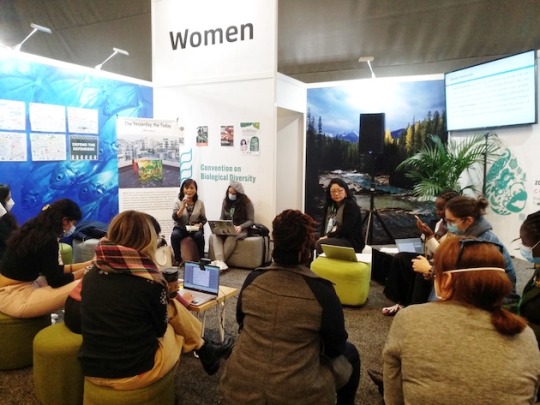
View On WordPress
0 notes